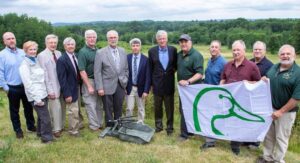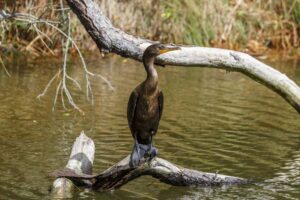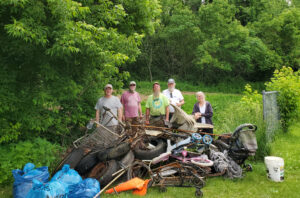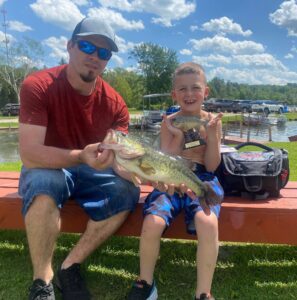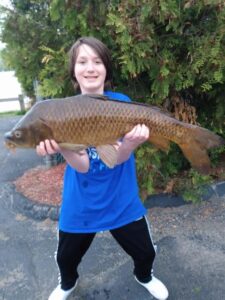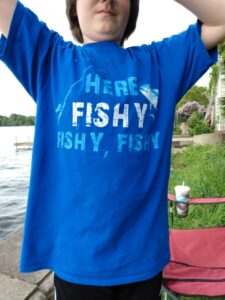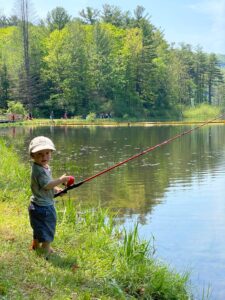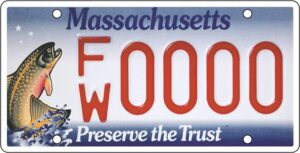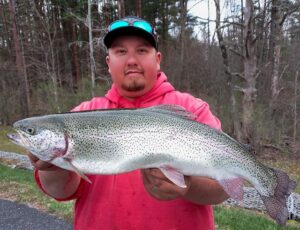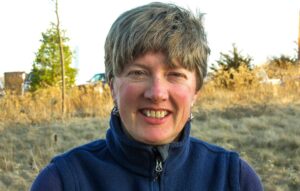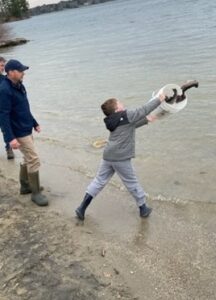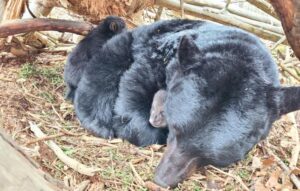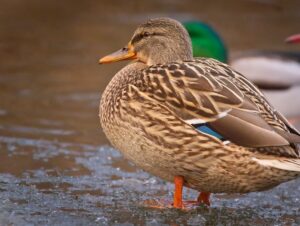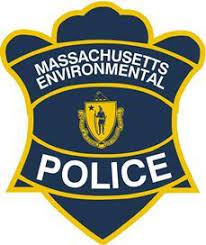The following is a news release from MassWildlife:
“On June 22, state officials accepted a special piece of waterfowl research equipment donated by the Massachusetts Chapter of Ducks Unlimited (DU) and Western Mass. Duck Hunters (WMDH). A tub net launcher is a tool used by trained wildlife biologists in the field to capture waterfowl like mallards and black ducks for banding.
“We are extremely grateful for our ongoing partnership with Ducks Unlimited and Western Mass. Duck Hunters,” said Mark S. Tisa, MassWildlife Director. “This equipment donation will make a huge difference in our capacity to band and study ducks, and will be put to use by our biologists right away this summer.”
In the field, biologists bait a small area with corn, wait for the birds to congregate, then use the tub launcher to discharge a net that is capable of capturing many ducks at once. Biologists place a leg band on each bird with a unique ID code and record data like sex, location, and species before releasing them. This information is critical to the conservation and management of waterfowl, as biologists gather data on the movements and survival of these birds across the Atlantic flyway.
“I want to thank the hunters who put in the time and energy to fundraise and provide a piece of equipment the state was in desperate need of,” said Ron Amidon, Department of Fish and Game Commissioner. “Your generous donation will directly support conservation work right here in Massachusetts.”
Securing this piece of research equipment was not an easy task, as tub net launchers are hard to find and must be custom built. Dedicated volunteers from DU and WMDH organized all the fundraising to purchase the equipment and found a company willing to build the custom tool.
“It took many months but I am very proud of our dedicated members who really stepped up to help fund this research,” said John Dow, State Chair for the Massachusetts Chapter of Ducks Unlimited. “We are always looking for opportunities to partner and support local conservation projects.”
“Part of our club’s purpose is to understand waterfowl populations, maintain critical habitat, and advance wildlife education,” said Ed Snyder, longtime member of Western Mass. Duck Hunters. “Our volunteers have been supporting conservation efforts like this for years, such as the installation and maintenance of nesting boxes for wood ducks.”
Hunters play a critical role in funding and supporting wildlife conservation. For example, Ducks Unlimited has been a key partner to MassWildlife in many recent conservation projects, including the restoration of wetland habitat at Burrage Pond Wildlife Management Area in Hanson and the improvement of public access sites at Three Mile Pond Wildlife Management Area in Sheffield. All hunters contribute to the funding of wildlife management, as proceeds from hunting licenses, permits, and stamps, as well as a portion of federal excise taxes on hunting equipment, is given to state fish and wildlife agencies for conservation”.
Stuff like this makes me proud to be a member of such outdoor organizations.
North Adams’ Hoosic River: past, present, and future
Judy Grinnell, the founder of the Hoosic River Revival (HRR), and Cary Kandel, an HRR board member and clerk of the board, will speak at the July Pittsfield Green Drinks event on Tuesday, July 19, at 6:00 PM on Zoom. Judy and Cary will dive into the history of the Hoosic River, a 76-mile-long tributary of the Hudson River that partially runs through the northern Berkshires. They’ll talk about the many facets of Hoosic River Valley history, the great things it’s brought to this area for centuries, and the challenges.
As part of the discussion, Grinnell and Kandel will take a brief ‘look back’ at our Hoosic River Valley history from its Mohican, Colonial, Industrial, and fledgling Tech days. They will also address the River’s blessings, challenges, and the solution to those challenges: a three-sided concrete sluice. With current information about river restoration and relevant conceptual plans, they will share the current status of the local, state, and federal government’s roles in the development of a healthy, accessible, flood-controlled downtown river in North Adams.
Judy Grinnell is a former French teacher, Williams College conferences director, and Storey Publishing sales manager. She has also led and participated in many Berkshire County organizations, such as the League of Women Voters, the Mt. Greylock School Committee, and the Northern Berkshire United Way Board of Directors. Since 2008, she has been advocating for a modernization of the aging, unattractive, flood-controlled section of the Hoosic River in North Adams.
Cary Kandel is an avid outdoorswoman, bird watcher, and health care practitioner. She has a strong interest in the relationship between the health and resilience of a community and its surrounding natural environment. Now working as a physical therapist at the Berkshire Medical Center, she has a keen interest in creating engaging activities that will inspire others to support the restoration of the River.
Pittsfield Green Drinks is an informal gathering on the third Tuesday of the month. These nights are free and open to everyone with any environmental interest. The drinks aren’t green but the conversations are.
***Due to COVID-19, these events are virtual until further notice.
This event will take place on Zoom. Registration is required to join. You can register at: https://tinyurl.com/July2022-Green-Drinks
Pittsfield Green Drinks is sponsored by the Berkshire Environmental Action Team (BEAT). For more information (and photos) regarding Pittsfield Green Drinks, contact Chelsey Simmons, chelsey@thebeatnews.org, (413) 464-9402.
Pistol License Course
The Lee Sportsmen’s Association (LSA) will be sponsoring a Massachusetts Pistol License Course on Saturday, July 23. This course qualifies participants to apply for a Massachusetts FID or LTC, plus pistol licenses in other states. This comprehensive one-day course includes information for federal and state firearm laws, operation and safe handling of firearms, shooting fundamentals, care and cleaning, concealed carry methods, a live fire session on the LSA Indoor Pistol Range, and much more.
Course fee is $160 due in cash on the day of the course. State license application fees and processing are not included. Participants will receive a course certificate, application forms, other resources, supporting documents and new Walker’s earmuffs and safety glasses that are theirs to keep. Club membership applications will be available at the course.
To register, visit www.NRApistolinstructor.com and use the Contact form; provide your full name including middle initial, date of birth, course date, course selection (Massachusetts Pistol License Course (LTC-020) at Lee Sportsmen’s Association with date), address, telephone, and email contact information. Payment is due in cash at the course.
Check-in starts at 8:30am, and the course will run from 9am until approximately 1:30pm.
For more information contact Robert McDermott at (413) 232-7700 or email robmcdermott@verizon.net.
West Branch Housatonic River Cleanup
On Saturday, July 23, from 9 AM – 1 PM, volunteers are invited to help clean up the West Branch of the Housatonic River.
Cleanups make a considerable difference in the health of the Housatonic River. Over the years, Berkshire Environmental Action Team (BEAT) and Housatonic Valley Association (HVA) have collected a startling array of debris. Since beginning annual cleanups, their efforts have made a noticeable difference, with the piles of trash getting smaller.
Meet at Wahconah Park, 105 Wahconah Street, Pittsfield. Cleanup teams will disperse to nearby locations, gathering miscellaneous trash from the river banks and bottom. Canoes will be used to transport the trash. Old clothes, a hat, sunscreen, old sneakers or waterproof boots/waders, a full water bottle, and sunglasses are recommended.
West Branch river cleanups are organized by BEAT and HVA and co-sponsored by Blue Q, the City of Pittsfield, and American Rivers. The cleanup will be canceled in the event of pouring rain or thunder.
For more information or to register to volunteer, contact BEAT at team@thebeatnews.org or call (413)464-9402.
Berkshire Natural Fish Hatchery Youth Fishing Derby
The Friends of the Berkshire National Fish Hatchery in conjunction with the U.S. Fish & Wildlife Service will be sponsoring a free fishing derby today at the lower pond of the Berkshire National Fish Hatchery, 240 Hatchery Road, New Marlborough from 9:00 am to 10:30 am for children 13 and under. They must be accompanied by an adult. My apologies for this late notice.

